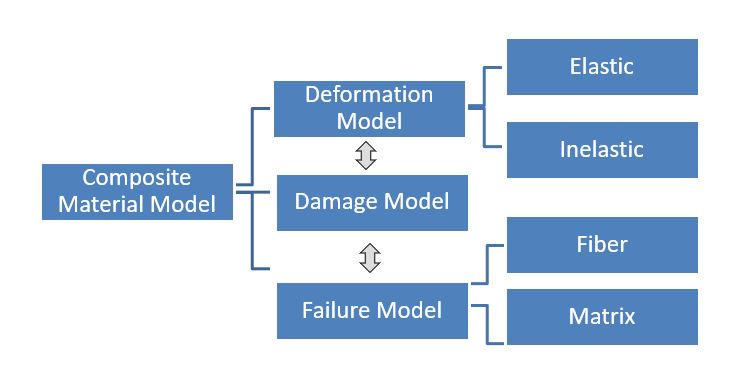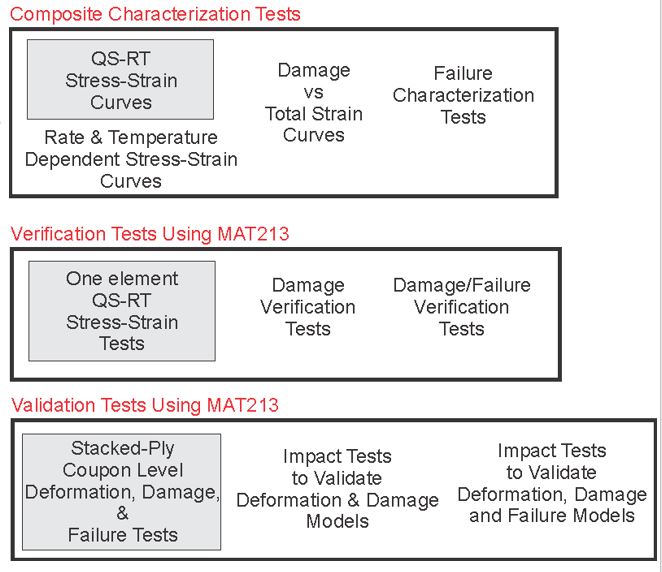To verify and validate material models requires use of experimental data. Typically, the starting point is a suite of material tests to characterize the behavior of the material. We use the Structural and Material Testing Laboratory (ISTB2-155) to obtain the stress-strain curves and other material properties for a variety of materials including composites.
Details
Research work carried out under the auspices of Computational and Experimental Mechanics (CEM) laboratory deals primarily with structural composites. Major funding for the research work has come from the Federal Aviation Administration (FAA) and the National Aeronautics and Space Administration (NASA). Both FAA and NASA (Glenn & Langley) researchers have worked closely with ASU in advancing the expertise with structural and aerospace composite materials. The other collaborators include Livermore Software Technology Corporation (LSTC), the Ohio State University and George Mason University.
Composites for Aerospace Structures and Impact Problems:
Composite materials are now beginning to provide uses hitherto reserved for metals, particularly in applications where impact resistance is critical. Such applications include structures such as airframes and engine containment systems, wraps for repair and rehabilitation, and ballistic/blast mitigation systems. While material models exist that can be used to simulate the response of a variety of materials in these demanding structural applications under impact conditions, the mature material models have focused on simulating the response of standard materials such as metals, elastomers and wood. Material models to simulate the nonlinear and/or impact response of composites have been developed, but the maturity and capabilities of these models are at a much lower level than those that have been developed for standard materials. General constitutive models designed for simulating the impact response of composite materials generally require three components – an elastic and inelastic deformation capability that relates deformations to strains and stresses, a damage capability that captures the stiffness degradation of the material, and a failure capability. Incorporating these three components into a single unified model that is applicable for use for a wide variety of composite material systems and architectures is a significant challenge. In this section, the details of some of publicly available models are briefly discussed, illustrating the challenges in developing an accurate composite deformation and damage model. The need for a more mature model at the macro (e.g. laminate level) scale suitable for use in large scale impact simulations is the focus of our work.
This research work has resulted in the development of an elasto-plastic orthotropic generalized composite material model implemented in a commercial finite element computer program as *MAT_COMPOSITE_TABULATED_PLASTICITY_DAMAGE or, *MAT_213.
Building a Constitutive Model for Orthotropic Composites
The constitutive model architecture is shown below. It has three sub-models – one for deformation prediction, one for handling damage, and one for the implemented failure models. The figure on the right shows how one might characterize their composite for use with MAT_213.


The FAA and NASA-sponsored research work has resulted in an orthotropic, plasticity model implemented in LS-DYNA commercial computer program as MAT_213.
Experimental Characterization of Orthotropic Composite Materials
The Structures Laboratory is used to carry out the experimental mechanics part of the research work. Some of the equipment used in the material characterization tests are shown below.

They include MTS and Instron test frames, various grips and fixtures to hold the composite samples and carry out different types of tests, and imaging equipment and software to measure and analyze full field displacements and strains.
Journal Publications
More details of the research effort and findings can be found in the following journal publications.
R. Goldberg, K. Carney, P. DuBois, C. Hoffarth, J. Harrington, S.D. Rajan and G. Blankenhorn, “Development of an Orthotropic Elasto-Plastic Generalized Composite Material Model Suitable for Impact Problems”, ASCE J of Aerospace Engineering, doi: 10.1061/(ASCE)AS.1943-5525.0000580. Dec 2015. Also 29:4, 1-11, 2016.
C. Hoffarth, S.D. Rajan, R. Goldberg, K. Carney, P. DuBois, and G. Blankenhorn, “Implementation and Validation of a Three-Dimensional Plasticity-Based Deformation Model for Orthotropic Composites”, Composites A, http://dx.doi.org/10.1016/j.compositesa.2016.10.024, 91:1, 336-350, December 2016.
C. Hoffarth, B. Khaled, L. Shyamsunder, S.D. Rajan, R. Goldberg, K. Carney, P. DuBois, and G. Blankenhorn, “Verification and Validation of a Three-Dimensional Orthotropic Plasticity Constitutive Model Using a Unidirectional Composite”, Fibers, 5(1), 12; doi:10.3390/fib5010012, March 2017.
J. Harrington, C. Hoffarth, S.D. Rajan, R. Goldberg, K. Carney, P. DuBois, and G. Blankenhorn, “Using Virtual Tests to Complete the Description of a Three-Dimensional Orthotropic Material”, ASCE J of Aerospace Engineering, DOI: 10.1061/(ASCE)AS.1943-5525.0000737, March 2017.
B. Khaled, L. Shyamsunder, C. Hoffarth, S.D. Rajan, R.K. Goldberg, K.S. Carney, P. DuBois, and G. Blankenhorn, “Experimental Characterization of Composites to Support an Orthotropic Plasticity Material Model”, J of Composite Materials, DOI: 10.1177/0021998317733319, August 2017.
R. Goldberg, K. Carney, P. DuBois, C. Hoffarth, B. Khaled, S.D. Rajan and G. Blankenhorn, “Analysis and Characterization of Damage Utilizing a Generalized Composite Material Model Suitable for Impact Problems”, ASCE J of Aerospace Engineering, 10.1061/(ASCE)AS.1943-5525.0000854, March 2018.
R. Goldberg, K. Carney, P. DuBois, C. Hoffarth, B. Khaled, L. Shyamsunder, S.D. Rajan and G. Blankenhorn, “Implementation of a Tabulated Failure Model Into a Generalized Composite Material Model”, J of Composite Materials, https://doi.org/10.1177/0021998318786778, July 10, 2018.
B. Khaled, L. Shyamsunder, C. Hoffarth, S.D. Rajan, R.K. Goldberg, K.S. Carney, P. DuBois, and G. Blankenhorn, “Damage Characterization of Composites to Support an Orthotropic Plasticity Material Model”, J of Composite Materials, doi:10.1177/0021998318793506, August 2018.

